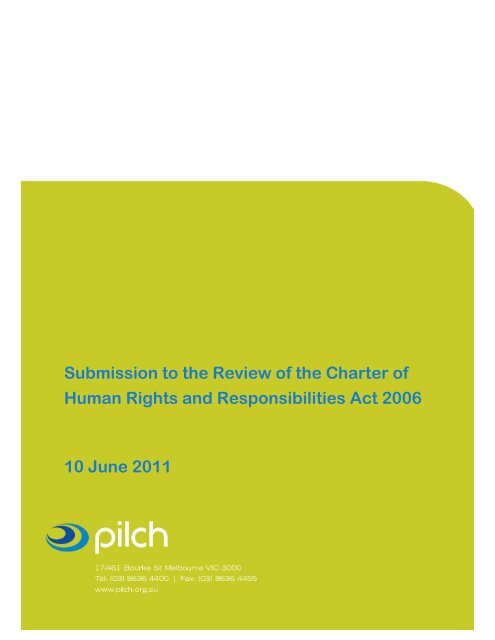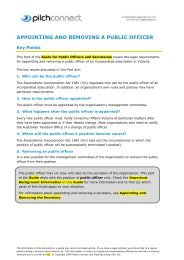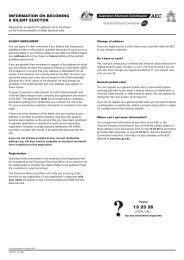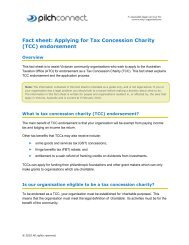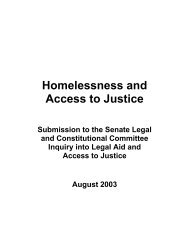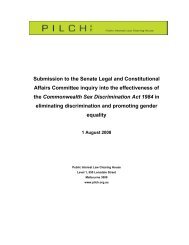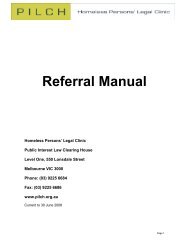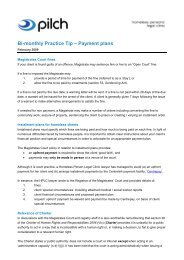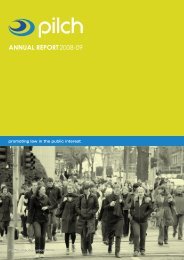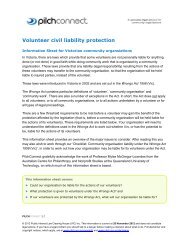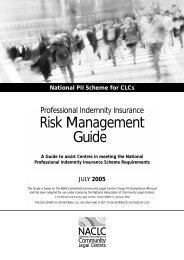PILCH submission to the Victorian Charter Review 2011
PILCH submission to the Victorian Charter Review 2011
PILCH submission to the Victorian Charter Review 2011
You also want an ePaper? Increase the reach of your titles
YUMPU automatically turns print PDFs into web optimized ePapers that Google loves.
Submission <strong>to</strong> <strong>the</strong> <strong>Review</strong> of <strong>the</strong> <strong>Charter</strong> of<br />
Human Rights and Responsibilities Act 2006<br />
10 June <strong>2011</strong>
Acknowledgments<br />
<strong>PILCH</strong> acknowledges <strong>the</strong> work of <strong>the</strong> solici<strong>to</strong>rs at its member firms and members of <strong>the</strong> Vic<strong>to</strong>rian Bar Pro<br />
Bono Scheme who have dedicated <strong>the</strong>ir time pro bono <strong>to</strong> acting in <strong>the</strong> matters referred <strong>to</strong> in this <strong>submission</strong>.<br />
<strong>PILCH</strong> also acknowledges <strong>the</strong> clients who have generously agreed <strong>to</strong> us telling <strong>the</strong>ir s<strong>to</strong>ries in <strong>the</strong> case<br />
studies contained in this <strong>submission</strong>.<br />
Gregor Husper and Charlotte Ahearne<br />
<strong>PILCH</strong> Referrals Scheme<br />
www.pilch.org.au<br />
T: 03 8636 4000
Contents<br />
1. Executive summary........................................................................................................................ 1<br />
1.1 Overview............................................................................................................................................... 1<br />
1.2 Terms of Reference.............................................................................................................................. 1<br />
1.3 Summary of key points and recommendations .................................................................................... 2<br />
2. About <strong>PILCH</strong> ................................................................................................................................... 3<br />
2.1 Background........................................................................................................................................... 3<br />
2.2 Pro bono criteria ................................................................................................................................... 3<br />
2.3 Resourcing of <strong>the</strong> Schemes ................................................................................................................. 4<br />
3. The effects of <strong>the</strong> <strong>Charter</strong> on <strong>the</strong> development, drafting and consideration of statu<strong>to</strong>ry<br />
provisions......................................................................................................................................................... 4<br />
3.1 The dialogue model .............................................................................................................................. 4<br />
3.2 Front end – <strong>the</strong> role of Parliament and SARC...................................................................................... 4<br />
4. The effect of <strong>the</strong> <strong>Charter</strong> on <strong>the</strong> provision of services and performance of functions by<br />
public authorities............................................................................................................................................. 6<br />
4.1 <strong>Charter</strong>-based advocacy leads <strong>to</strong> improved, sensible decision-making processes and practices<br />
within public authorities...................................................................................................................................... 6<br />
5. The effects of <strong>the</strong> <strong>Charter</strong> on litigation and <strong>the</strong> roles of courts and tribunals ........................ 8<br />
5.1 Back end – <strong>the</strong> role for courts and tribunals......................................................................................... 8<br />
6. Access <strong>to</strong> effective remedies under <strong>the</strong> <strong>Charter</strong> for <strong>the</strong> infringement of rights.................... 10<br />
7. Overall benefits and costs of <strong>the</strong> <strong>Charter</strong>.................................................................................. 11<br />
8. Options for improvement and streng<strong>the</strong>ning of rights protection ......................................... 11<br />
8.1 Protections of economic and social rights .......................................................................................... 12<br />
8.2 Independent cause of action and damages ....................................................................................... 12<br />
8.3 Recognition of absolute rights ............................................................................................................ 12<br />
8.4 Manda<strong>to</strong>ry moni<strong>to</strong>ring of public authorities’ human rights compliance............................................... 12
1 Executive summary<br />
1.1 Overview<br />
The Public Interest Law Clearing House (<strong>PILCH</strong>) welcomes <strong>the</strong> opportunity <strong>to</strong> make a <strong>submission</strong> <strong>to</strong> <strong>the</strong><br />
Scrutiny of Acts and Regulations Committee (SARC) as part of <strong>the</strong> Inquiry in<strong>to</strong> <strong>the</strong> <strong>Charter</strong> of Human Rights<br />
and Responsibilities Act 2006 (<strong>the</strong> Inquiry).<br />
We commend <strong>the</strong> Vic<strong>to</strong>rian Government for its good faith, evidence-based approach <strong>to</strong> reviewing <strong>the</strong><br />
operation and impact of <strong>the</strong> <strong>Charter</strong> of Human Rights and Responsibilities Act 2006 (Vic) (<strong>Charter</strong>).<br />
<strong>PILCH</strong> fully endorses <strong>the</strong> <strong>submission</strong> and recommendations made by <strong>the</strong> Human Rights Law Centre<br />
(HRLC), which is recognised as a leading Australian expert organisation on domestic and international<br />
human rights law. <strong>PILCH</strong> also endorses <strong>the</strong> <strong>submission</strong> made by <strong>the</strong> <strong>PILCH</strong> Homeless Persons’ Legal Clinic<br />
(HPLC), a <strong>PILCH</strong> program that provides legal advice and assistance <strong>to</strong> Vic<strong>to</strong>rians who are homeless or at<br />
risk of homelessness.<br />
This <strong>submission</strong> addresses aspects of <strong>the</strong> <strong>Charter</strong>’s operation that <strong>PILCH</strong> has observed in its role as a<br />
clearing house for pro bono legal work that has a broad public interest character and/or responds <strong>to</strong> unmet<br />
legal need in <strong>the</strong> community.<br />
This <strong>submission</strong> contains four specific case studies of clients for whom <strong>the</strong> <strong>Charter</strong> has been used <strong>to</strong><br />
negotiate and advocate and/or litigate for a fairer outcome in <strong>the</strong> provision of services, which in <strong>PILCH</strong>’s view<br />
represent examples of <strong>the</strong> broad benefits of <strong>the</strong> operation and impact of <strong>the</strong> <strong>Charter</strong> <strong>to</strong> date. All clients have<br />
been de-identified for privacy reasons. The case studies are predominantly in <strong>the</strong> area of discrimination<br />
against same sex couples, children with a disability, people subject <strong>to</strong> guardianship orders and homosexual<br />
youth. In this respect, <strong>the</strong>y engage specifically with <strong>the</strong> right <strong>to</strong> recognition and equality before <strong>the</strong> law<br />
contained in s 8 of <strong>the</strong> <strong>Charter</strong>.<br />
The case studies demonstrate <strong>the</strong> way in which <strong>the</strong> <strong>Charter</strong> has been used <strong>to</strong> bring about just, fair, efficient<br />
and commonsense outcomes, whe<strong>the</strong>r by negotiation, advocacy or litigation (whe<strong>the</strong>r or not pursued <strong>to</strong><br />
judgment). They also illustrate <strong>the</strong> effectiveness of <strong>the</strong> <strong>Charter</strong> in establishing a dialogue about human rights<br />
in <strong>the</strong> community, amongst public authorities and in <strong>the</strong> parliamentary scrutiny process. The benefit of a<br />
human rights dialogue is that decisions about drafting and administering legislation can be informed by a<br />
single overarching framework of fairness that is <strong>the</strong> same framework that is applied by courts and tribunals<br />
and implemented on <strong>the</strong> ground by decision makers in public authorities.<br />
1.2 Terms of Reference<br />
Informed by our experience using <strong>the</strong> <strong>Charter</strong> in our advocacy and negotiation, in this <strong>submission</strong> we<br />
comment on <strong>the</strong> impact and operation of <strong>the</strong> <strong>Charter</strong> with respect <strong>to</strong> <strong>the</strong> following Terms of Reference (TOR):<br />
► <strong>the</strong> effects of <strong>the</strong> <strong>Charter</strong> on <strong>the</strong> development and drafting of statu<strong>to</strong>ry provisions (TOR 5(a));<br />
► <strong>the</strong> effects of <strong>the</strong> <strong>Charter</strong> on <strong>the</strong> provision of services, and <strong>the</strong> performance of o<strong>the</strong>r functions, by public<br />
authorities (TOR 5(c));<br />
► <strong>the</strong> effects of <strong>the</strong> <strong>Charter</strong> on litigation and <strong>the</strong> roles and functioning of courts and tribunals (TOR 5(d));<br />
► <strong>the</strong> effects of <strong>the</strong> <strong>Charter</strong> on <strong>the</strong> availability of accessible, just and timely remedies for infringements of<br />
rights (TOR 5(e));<br />
► <strong>the</strong> overall benefits and costs of <strong>the</strong> <strong>Charter</strong> (TOR 6); and<br />
► options for reform or improvement of <strong>the</strong> regime for protecting and upholding rights and responsibilities<br />
in Vic<strong>to</strong>ria (TOR 7).<br />
In keeping with <strong>the</strong> evidence-base approach required by <strong>the</strong> Inquiry, we have only addressed <strong>the</strong> TORs for<br />
which our experience is directly relevant.<br />
<strong>PILCH</strong> Submission on Vic<strong>to</strong>ria’s <strong>Charter</strong> of Human Rights<br />
<strong>PILCH</strong> 1
1.3 Summary of key points and recommendations<br />
In this <strong>submission</strong>, <strong>PILCH</strong> uses various case studies of clients it has referred <strong>to</strong> private legal practitioners for<br />
pro bono assistance. Our clients tend <strong>to</strong> be disadvantaged individuals who receive government income<br />
support, have a disability or belong <strong>to</strong> a minority group within <strong>the</strong> community. Through its referral work,<br />
<strong>PILCH</strong> is in a unique position <strong>to</strong> recognise trends in unmet legal need and <strong>the</strong> discrimina<strong>to</strong>ry effects of<br />
legislation or administrative decisions.<br />
In our experience, <strong>the</strong> <strong>Charter</strong> has provided a practical and effective <strong>to</strong>ol <strong>to</strong> achieve improved access <strong>to</strong><br />
justice for members of <strong>the</strong> community eligible for pro bono legal assistance. Our clients’ use of <strong>the</strong> <strong>Charter</strong><br />
<strong>to</strong> advocate for <strong>the</strong> non-discrimina<strong>to</strong>ry, fair and common sense application of laws has highlighted inequality<br />
of access <strong>to</strong> government services and has resulted, in at least two cases, in beneficial changes <strong>to</strong> <strong>the</strong> law.<br />
Much of this impact has been achieved through sustained negotiation and, in some cases, <strong>the</strong> initiation of<br />
proceedings in a court or tribunal.<br />
While negotiated outcomes and systemic changes in policies and practices are where <strong>PILCH</strong> considers <strong>the</strong><br />
<strong>Charter</strong> has its greatest impact, <strong>the</strong>se results would not have been so efficiently and effectively delivered<br />
(and may not have occurred at all), in <strong>the</strong> absence of <strong>the</strong> three-pronged obligations under <strong>the</strong> <strong>Charter</strong>’s<br />
dialogue model. Formal protection of human rights in legislation, which places obligations on Parliament and<br />
public authorities and contains a role for courts and tribunals, is imperative for <strong>the</strong> effective protection and<br />
enhancement of justice and fairness in Vic<strong>to</strong>ria. In <strong>the</strong> absence of any part of this model, we would not have<br />
seen <strong>the</strong> positive outcomes that have been delivered <strong>to</strong> Vic<strong>to</strong>rians since 2007.<br />
However, our experience also demonstrates that, for <strong>the</strong> <strong>Charter</strong> <strong>to</strong> be more effective in protecting and<br />
upholding peoples’ rights, <strong>the</strong>re should be provision for an independent cause of action and <strong>the</strong> Vic<strong>to</strong>rian<br />
Equal Opportunity and Human Rights Commission (VEOHRC) should be empowered <strong>to</strong> conciliate human<br />
rights complaints. This would ensure that all Vic<strong>to</strong>rians are able <strong>to</strong> access an effective remedy for any<br />
infringement of <strong>the</strong>ir human rights.<br />
<strong>PILCH</strong>’s recommendations are as follows:<br />
1.3.1.1 Recommendation 1<br />
The <strong>Charter</strong> should be amended <strong>to</strong> empower VEOHRC <strong>to</strong> receive and conciliate human rights complaints<br />
using a similar process <strong>to</strong> that available for discrimination complaints under <strong>the</strong> Equal Opportunity Act 2010<br />
(Vic).<br />
1.3.1.2 Recommendation 2<br />
Sections 32 and 36 of <strong>the</strong> <strong>Charter</strong> should be repealed and replaced with a provision which states that:<br />
• by way of express provision, parliament may enact legislation which is valid and operates<br />
notwithstanding any incompatibility with human rights;<br />
• absent such express provision, a law is not <strong>to</strong> be construed and applied in a way which abrogates,<br />
abridges or infringes human rights; and<br />
• any law which cannot be so construed and applied is invalid <strong>to</strong> <strong>the</strong> extent of that inconsistency.<br />
1.3.1.3 Recommendation 3<br />
Section 39 of <strong>the</strong> <strong>Charter</strong> should be replaced with a provision that establishes a free-standing cause of<br />
action for breaches of protected human rights which is justiciable and enforceable in <strong>the</strong> appropriate court or<br />
tribunal, including VCAT.<br />
<strong>PILCH</strong> Submission on Vic<strong>to</strong>ria’s <strong>Charter</strong> of Human Rights<br />
<strong>PILCH</strong> 2
2 About <strong>PILCH</strong><br />
2.1 Background<br />
<strong>PILCH</strong> is a leading Vic<strong>to</strong>rian, not-for-profit organisation committed <strong>to</strong> fur<strong>the</strong>ring <strong>the</strong> public interest, improving<br />
access <strong>to</strong> justice and protecting human rights. <strong>PILCH</strong> does this by facilitating <strong>the</strong> provision of pro bono legal<br />
services (primarily <strong>to</strong> people located in Vic<strong>to</strong>ria) through five pro bono legal assistance schemes, which<br />
operate from <strong>the</strong> <strong>PILCH</strong> office:<br />
► <strong>the</strong> Public Interest Law Scheme (PILS), <strong>the</strong> Vic<strong>to</strong>rian Bar Pro Bono Scheme (VBPBS) and <strong>the</strong> Law<br />
Institute of Vic<strong>to</strong>ria Legal Assistance Scheme (LIVLAS) (<strong>to</strong>ge<strong>the</strong>r, <strong>the</strong> Referral Schemes);<br />
► <strong>the</strong> Homeless Persons’ Legal Clinic (HPLC), which provides civil, administrative and some summary<br />
criminal legal services at crisis accommodation centres and welfare agencies;<br />
► <strong>PILCH</strong> Connect - a specialist service for community organisations; and<br />
► <strong>the</strong> Seniors Rights Legal Clinic (SRLC), a specialty legal clinic focusing on assisting older Vic<strong>to</strong>rians in<br />
relation <strong>to</strong> elder abuse and o<strong>the</strong>r issues associated with ageing.<br />
(<strong>to</strong>ge<strong>the</strong>r, The Schemes).<br />
Clients who are eligible for assistance through any of <strong>the</strong>se schemes are referred <strong>to</strong> a solici<strong>to</strong>r at a member<br />
firm or a barrister who will act for <strong>the</strong>m on a pro bono basis. <strong>PILCH</strong>’s members comprise commercial law<br />
firms, <strong>the</strong> Vic<strong>to</strong>rian Bar, corporate legal departments, universities and community legal centres.<br />
In <strong>the</strong> financial year ending June 2010, <strong>the</strong> Referral Scheme made 220 pro bono referrals <strong>to</strong> member law<br />
firms and LIV practitioners and 300 pro bono referrals <strong>to</strong> barristers. In <strong>the</strong> same period <strong>PILCH</strong> Connect made<br />
121 pro bono referrals <strong>to</strong> member firms and gave telephone advice <strong>to</strong> 204 not-for-profits. Information on <strong>the</strong><br />
HPLC’s work is contained in its <strong>submission</strong> <strong>to</strong> <strong>the</strong> Inquiry, Charting <strong>the</strong> Right Course.<br />
Through its pro bono referral scheme and in undertaking law reform, policy work and legal education, <strong>PILCH</strong><br />
seeks <strong>to</strong>:<br />
► address disadvantage and marginalisation in <strong>the</strong> community;<br />
► effect structural change <strong>to</strong> address injustice;<br />
► foster a strong pro bono culture in Vic<strong>to</strong>ria; and<br />
► increase <strong>the</strong> pro bono capacity of <strong>the</strong> legal profession.<br />
2.2 Pro bono criteria<br />
The Schemes receive, assess and refer requests for pro bono legal assistance <strong>to</strong> <strong>the</strong> private legal<br />
profession. The Schemes only provide assistance where applicants meet a means test, where <strong>the</strong>ir matter<br />
has legal merit, and where legal assistance is not available from ano<strong>the</strong>r source (eg, Vic<strong>to</strong>ria Legal Aid or a<br />
community legal centre).<br />
The PILS Scheme has an additional criterion. It only refers public interest matters <strong>to</strong> <strong>PILCH</strong> members. Public<br />
interest matters are:<br />
► legal matters for non-profit organisations with public interest objectives; or<br />
► individuals’ matters where that matter raises an issue which:<br />
• affects a significant number of people, not just <strong>the</strong> individual;<br />
• is of broad public concern; or<br />
• impacts on disadvantaged or marginalised groups.<br />
<strong>PILCH</strong> Submission on Vic<strong>to</strong>ria’s <strong>Charter</strong> of Human Rights<br />
<strong>PILCH</strong> 3
2.3 Resourcing of <strong>the</strong> Schemes<br />
2.3.1.1 The Referral Scheme<br />
The Public Interest Law Scheme is funded by <strong>the</strong> annual fees paid by its members and various fund raising<br />
activities. VBPBS is funded by <strong>the</strong> Vic<strong>to</strong>rian Bar, with <strong>the</strong> support of <strong>the</strong> Legal Practice Board. .Over 700<br />
barristers at <strong>the</strong> Vic<strong>to</strong>rian Bar have registered <strong>the</strong>ir willingness <strong>to</strong> act on a pro bono basis through VBPBS.<br />
The Law Institute of Vic<strong>to</strong>ria, with <strong>the</strong> support of <strong>the</strong> Legal Practice Board, funds LIVLAS. Over 150 firms and<br />
individual solici<strong>to</strong>rs have registered <strong>the</strong>ir willingness <strong>to</strong> act on a pro bono basis through LIVLAS.<br />
2.3.1.2 HPLC<br />
HPLC is funded by <strong>the</strong> Commonwealth Legal Services Program, administered by Vic<strong>to</strong>ria Legal Aid. Legal<br />
services are provided by volunteer lawyers from <strong>PILCH</strong> member firms. HPLC has submitted a separate<br />
<strong>submission</strong> <strong>to</strong> <strong>the</strong> Inquiry, specific <strong>to</strong> <strong>the</strong> experiences of its particular client group, which <strong>PILCH</strong> endorses.<br />
2.3.1.3 <strong>PILCH</strong> Connect<br />
<strong>PILCH</strong> Connect provides telephone advice and delivers training <strong>to</strong> not-for-profits, as well as facilitating pro<br />
bono referrals <strong>to</strong> member firms. <strong>PILCH</strong> Connect is funded through a combination of philanthropic and<br />
government grants.<br />
2.3.1.4 SRLC<br />
The SRLC is a joint venture partnership between <strong>PILCH</strong>, Council on <strong>the</strong> Ageing (COTA) and Eastern and<br />
Loddon Campaspe Community Legal Centres. The SLRC is funded by Vic<strong>to</strong>ria Legal Aid and <strong>the</strong> Office of<br />
Senior Vic<strong>to</strong>rians. Legal services are provided by volunteer lawyers from <strong>PILCH</strong> member firms at legal clinics<br />
in hospitals and health centres around Melbourne.<br />
3 The effects of <strong>the</strong> <strong>Charter</strong> on <strong>the</strong> development,<br />
drafting and consideration of statu<strong>to</strong>ry provisions<br />
This section addresses Term of Reference 5(a).<br />
3.1 The dialogue model<br />
The dialogue model is key <strong>to</strong> <strong>the</strong> <strong>Charter</strong>’s effectiveness. The three-pronged obligations under <strong>the</strong> <strong>Charter</strong> –<br />
on Parliament, public authorities and <strong>the</strong> courts – work <strong>to</strong>ge<strong>the</strong>r <strong>to</strong> ensure that human rights are<br />
appropriately considered by all arms of government in Vic<strong>to</strong>ria.<br />
This model entrenches a system where: human rights are taken in<strong>to</strong> consideration from <strong>the</strong> outset (i.e. in<br />
preparing laws); public authorities build human rights in<strong>to</strong> <strong>the</strong>ir practices and decision-making processes;<br />
and, as a last resort, <strong>the</strong>re is recourse <strong>to</strong> courts and tribunals. If one or more of <strong>the</strong>se elements is removed,<br />
<strong>the</strong>re will be a gap in <strong>the</strong> system which is likely <strong>to</strong> undermine <strong>the</strong> achievements of <strong>the</strong> o<strong>the</strong>r elements.<br />
These ‘front end’ and ‘back end’ mechanisms, and <strong>the</strong> benefits <strong>the</strong>y bring in terms of more efficient and<br />
effective protection of rights for Vic<strong>to</strong>rians, are discussed in more detail below.<br />
3.2 Front end – <strong>the</strong> role of Parliament and SARC<br />
The mechanisms in Part 3 of <strong>the</strong> <strong>Charter</strong> ensure that human rights are considered in <strong>the</strong> initial stages of<br />
making and amending legislation and regulations. It also establishes that Parliament has <strong>the</strong> primary role in<br />
ensuring legislation is compatible with human rights under <strong>the</strong> <strong>Charter</strong>. We refer <strong>to</strong> this function as <strong>the</strong> ‘front<br />
end’ consideration of human rights.<br />
<strong>PILCH</strong> Submission on Vic<strong>to</strong>ria’s <strong>Charter</strong> of Human Rights<br />
<strong>PILCH</strong> 4
<strong>PILCH</strong> notes <strong>the</strong> VEOHRC’s observation that <strong>the</strong> requirement <strong>to</strong> prepare Statements of Compatibility has<br />
been a catalyst for increased community consultation and engagement in <strong>the</strong> formulation of legislation. 1<br />
Consultation with <strong>the</strong> community can only improve <strong>the</strong> ability of laws <strong>to</strong> be relevant and responsive <strong>to</strong> <strong>the</strong><br />
rights and needs of Vic<strong>to</strong>rians.<br />
‘Front end’ parliamentary scrutiny of proposed legislation for compatibility with human rights is important<br />
because it serves a preventative function in <strong>the</strong> following ways:<br />
► <strong>the</strong> avoidance (both <strong>to</strong> <strong>the</strong> state and <strong>to</strong> individuals) of costly litigation in <strong>the</strong> pursuit of an outcome that<br />
recognises an applicant’s human rights;<br />
► <strong>the</strong> avoidance of emotional costs and stresses <strong>to</strong> applicants pursuing litigation; and<br />
► preventing individuals from experiencing <strong>the</strong> consequences of a human rights breach.<br />
It also improves <strong>the</strong> transparency of <strong>the</strong> statu<strong>to</strong>ry development process by requiring <strong>the</strong> government <strong>to</strong> weigh<br />
competing interests when drafting legislation, and for SARC <strong>to</strong> critically appraise <strong>the</strong> human rights impact of<br />
prospective laws. This provides a system in which parliament can be clear about its intent regarding <strong>the</strong><br />
operation of legislation, including where <strong>the</strong> intention is <strong>to</strong> override a person’s human rights.<br />
Parts 3 and 4 of this <strong>submission</strong> consider some examples of <strong>the</strong> ‘front end’ consideration of human rights in<br />
<strong>the</strong> areas of equality before <strong>the</strong> law. These examples show <strong>the</strong> benefits of <strong>the</strong> dialogue model and <strong>the</strong><br />
importance of Parliament’s role. This process has, in Case Study 1, resulted in <strong>the</strong> redrafting of provisions <strong>to</strong><br />
address incompatibility with human rights.<br />
CASE STUDY 1: Woman in a same sex relationship denied <strong>the</strong> right <strong>to</strong> pass her<br />
reversionary superannuation benefits <strong>to</strong> her partner upon her death<br />
Gina is in a same sex relationship. She had received a pension from ABC Super Fund, in accordance<br />
with <strong>the</strong> State Superannuation Act 1988 (Vic) (<strong>the</strong> Act). In 2001 <strong>the</strong> Act was amended <strong>to</strong> allow for <strong>the</strong><br />
recognition of same sex relationships for <strong>the</strong> purposes of partners accessing reversionary benefits when<br />
<strong>the</strong>ir same sex partner died. However, <strong>the</strong> effect of <strong>the</strong> definition of ‘partner’ in <strong>the</strong> amending legislation<br />
(Statute Law Amendment (Relationships) Act 2001 (Vic) (<strong>the</strong> Amending Act)) was <strong>to</strong> exclude from <strong>the</strong><br />
reversionary benefits persons in same sex relationships who retired prior <strong>to</strong> 2001. The effect of <strong>the</strong> Act<br />
was <strong>to</strong> discriminate against people in same sex relationships, and particularly older people in same sex<br />
relationships. Gina was one such person.<br />
In November 2007 Gina sought advice from ABC Super Fund as <strong>to</strong> why her partner was not eligible for<br />
reversionary benefits in <strong>the</strong> case of her death. ABC Super Fund informed Gina that <strong>the</strong> amendments <strong>to</strong><br />
<strong>the</strong> Act that recognised same sex relationships for <strong>the</strong> purposes of superannuation were prospective<br />
only.<br />
Gina was unsuccessful in her application <strong>to</strong> <strong>the</strong> Vic<strong>to</strong>rian Equal Opportunity and Human Rights<br />
Commission alleging that ABC Super Fund and <strong>the</strong> responsible minister, Tim Holding MLA, were<br />
discriminating against her on <strong>the</strong> ground of her sexual orientation by denying her <strong>the</strong> right <strong>to</strong> pass her<br />
reversionary superannuation benefits <strong>to</strong> her partner upon her death. Her complaint was unsuccessful<br />
because s 69(1) of <strong>the</strong> Equal Opportunity Act 1995 (Vic) permitted discrimination if that discrimination<br />
was authorised by a provision of ano<strong>the</strong>r Act.<br />
1 VEOHRC, Talking Rights: 2010 Report on <strong>the</strong> Operation of <strong>the</strong> <strong>Charter</strong> of Human Rights and<br />
Responsibilities (<strong>2011</strong>) 35-6.<br />
<strong>PILCH</strong> Submission on Vic<strong>to</strong>ria’s <strong>Charter</strong> of Human Rights<br />
<strong>PILCH</strong> 5
Gina approached <strong>PILCH</strong> for a referral <strong>to</strong> counsel for an advice as <strong>to</strong> whe<strong>the</strong>r <strong>the</strong> definition of ‘partner’ in<br />
<strong>the</strong> Act was incompatible <strong>the</strong> right <strong>to</strong> equality and protection from discrimination under s 8(3) of <strong>the</strong><br />
<strong>Charter</strong>. Counsel advised that:<br />
The relevant provisions of <strong>the</strong> Act are discrimina<strong>to</strong>ry because a person’s eligibility for reversionary<br />
superannuation benefits will differ depending on his or her sexual orientation.<br />
The relevant provisions of <strong>the</strong> Act cannot be read in a way that is compatible with human rights, as<br />
required by s 32 of <strong>the</strong> <strong>Charter</strong> because <strong>the</strong> intention of <strong>the</strong> Act is clear and unambiguous and <strong>the</strong>re was<br />
no room for discretion.<br />
There is no independent cause of action <strong>to</strong> seek a declaration of inconsistent interpretation under s36 of<br />
<strong>the</strong> <strong>Charter</strong>. Therefore, in <strong>the</strong> absence of a non-<strong>Charter</strong> claim, Gina cannot seek a declaration of<br />
inconsistent interpretation.<br />
Gina advocated strongly for a change <strong>to</strong> <strong>the</strong> Act. Following Gina’s complaint <strong>to</strong> VEOHRC, on 7 April<br />
2008 VEOHRC wrote <strong>to</strong> <strong>the</strong> responsible minister and At<strong>to</strong>rney General noting that <strong>the</strong> less favourable<br />
treatment of people in same sex relationships under <strong>the</strong> Act ‘is a continuing concern of <strong>the</strong> Commission’.<br />
<strong>PILCH</strong>, on behalf of Gina, wrote <strong>to</strong> <strong>the</strong> Human Rights Unit at <strong>the</strong> Department of Justice raising<br />
awareness of <strong>the</strong> issue and seeking <strong>to</strong> determine <strong>the</strong> number of people affected by <strong>the</strong> discrimina<strong>to</strong>ry<br />
operation of <strong>the</strong> law.<br />
Following Gina and <strong>PILCH</strong>’s advocacy on this issue, an amendment was made <strong>to</strong> <strong>the</strong> Act with <strong>the</strong> effect<br />
that all persons, irrespective of sexual orientation, could access reversionary superannuation benefits<br />
retrospectively and prospectively from <strong>the</strong> date of <strong>the</strong> Amending Act.<br />
Had <strong>the</strong> amending act in Case Study 1 (above) been passed after <strong>the</strong> enactment of <strong>the</strong> <strong>Charter</strong>, it is possible<br />
that, in <strong>the</strong> process of preparing a statement of compatibility with <strong>the</strong> <strong>Charter</strong>, <strong>the</strong> discrimina<strong>to</strong>ry effect of <strong>the</strong><br />
Act would have been identified and an explanation would have been provided for <strong>the</strong> nature and extent of<br />
<strong>the</strong> incompatibility. Fur<strong>the</strong>r, an analysis under s 7(2) as <strong>to</strong> why a measure is ‘reasonable and necessary’<br />
would have allowed for parliamentary debate on <strong>the</strong> human rights issues triggered by <strong>the</strong> proposed<br />
legislation, and transparency and accountability in respect of <strong>the</strong> effect of denying a right <strong>to</strong> a section of <strong>the</strong><br />
community. This is <strong>the</strong> benefit of <strong>the</strong> front end approach.<br />
Case Study 1 also illustrates that <strong>the</strong> <strong>Charter</strong> could be more effective if it allowed applicants <strong>to</strong> pursue<br />
remedies under <strong>the</strong> <strong>Charter</strong> alone, without <strong>the</strong> need <strong>to</strong> ‘piggy back’ <strong>the</strong> <strong>Charter</strong> argument on an independent<br />
cause of action. We discuss this fur<strong>the</strong>r in section 8.2.<br />
At <strong>the</strong> very least, <strong>the</strong> <strong>Charter</strong> should be amended <strong>to</strong> empower VEOHRC <strong>to</strong> receive and conciliate human<br />
rights complaints (see Recommendation 1).<br />
4 The effect of <strong>the</strong> <strong>Charter</strong> on <strong>the</strong> provision of<br />
services and performance of functions by public<br />
authorities<br />
This section addresses Term of Reference 5(c).<br />
4.1 <strong>Charter</strong>-based advocacy leads <strong>to</strong> improved, sensible decision-making processes and<br />
practices within public authorities<br />
In <strong>the</strong> course of its referral work, <strong>PILCH</strong> can report that <strong>the</strong> <strong>Charter</strong> has been used <strong>to</strong> advocate for<br />
individuals who are impacted by laws or policies in a disproportionate or discrimina<strong>to</strong>ry way. The case study<br />
below exemplifies how <strong>the</strong> obligations placed on public authorities under <strong>the</strong> <strong>Charter</strong> – in this case <strong>the</strong><br />
<strong>PILCH</strong> Submission on Vic<strong>to</strong>ria’s <strong>Charter</strong> of Human Rights<br />
<strong>PILCH</strong> 6
Department of Human Services – contributed <strong>to</strong> a fairer application of departmental policies. It also<br />
demonstrates how <strong>the</strong> <strong>Charter</strong> can be used <strong>to</strong> expose decision-making within public authorities that is out of<br />
step with community values.<br />
CASE STUDY 2: 13 year old girl with Asperger’s Syndrome gains entitlement <strong>to</strong><br />
disability support services<br />
April (not her real name) has been diagnosed with Asperger’s Syndrome, which is an Autism Spectrum<br />
Disorder that is characterised by impaired social interaction, repetitive patters of behaviour and restricted<br />
interests, in individuals of normal intelligence. When April was 13 years old, her fa<strong>the</strong>r applied <strong>to</strong> <strong>the</strong><br />
Department of Human Services (DHS) for disability support services on April’s behalf. April had already<br />
been assessed as being eligible <strong>to</strong> receive a federal Disability Support Pension. DHS’s policy on<br />
determining disability recognised several categories of disability: sensory, physical, Acquired Brain<br />
Injury, intellectual disability, developmental delay and neurological impairment.<br />
DHS denied <strong>the</strong> request <strong>to</strong> access disability support services on <strong>the</strong> basis that Asperger’s Syndrome<br />
does not constitute a ‘neurological impairment’ and <strong>the</strong>refore was not a relevant ‘disability’ under s 3 of<br />
<strong>the</strong> Disability Act 2006. It became clear <strong>to</strong> April’s fa<strong>the</strong>r that this decision not only affected Tom but all<br />
Vic<strong>to</strong>rians with Autism Spectrum Disorder.<br />
With pro bono legal assistance, April’s fa<strong>the</strong>r appealed <strong>the</strong> decision of DHS <strong>to</strong> VCAT. At <strong>the</strong> hearing,<br />
Counsel made <strong>submission</strong>s arguing that DHS should adopt an inclusive and contextual interpretation of<br />
<strong>the</strong> terms ‘disability’ and ‘neurological impairment’ in accordance with its human rights obligations under<br />
<strong>the</strong> <strong>Charter</strong>. The decision of <strong>the</strong> Tribunal was reserved.<br />
Prior <strong>to</strong> <strong>the</strong> resolution of <strong>the</strong> case, <strong>the</strong> government announced that individuals with Autism Spectrum<br />
Disorders, including Asperger’s Syndrome, would be eligible <strong>to</strong> apply for disability support services. The<br />
government also announced funding of $2.75 million <strong>to</strong> support those individuals affected by <strong>the</strong> change.<br />
It is <strong>PILCH</strong>’s firm belief that, without <strong>the</strong> awareness raising served by <strong>the</strong> VCAT proceeding in Case Study 2,<br />
this change <strong>to</strong> <strong>the</strong> Department’s policy would not have occurred. In this respect, <strong>the</strong> <strong>Charter</strong> played a<br />
valuable role in persuading <strong>the</strong> Department <strong>to</strong> revisit its initial decision that Asperger’s Syndrome was not a<br />
relevant ‘disability’ under s 3 of <strong>the</strong> Disability Act 2006. As a result, a common sense decision was reached<br />
that also has broad and beneficial impacts for o<strong>the</strong>r children in April’s position.<br />
April’s fa<strong>the</strong>r has expressed <strong>to</strong> us his view that:<br />
‘The <strong>Charter</strong> was an important instrument in highlighting <strong>the</strong> rights of our son for access <strong>to</strong> funding<br />
support <strong>to</strong> ensure his educational and living support needs and opportunities were met. Its place in<br />
establishing <strong>the</strong> value of each person regardless of <strong>the</strong>ir disability, etc, as well as highlighting <strong>to</strong> all<br />
Vic<strong>to</strong>rians <strong>the</strong> needs of o<strong>the</strong>rs, was pivotal in providing access <strong>to</strong> services that would o<strong>the</strong>rwise not<br />
been available <strong>to</strong> us as a family and <strong>to</strong> our son. We are indebted <strong>to</strong> <strong>the</strong> value of <strong>the</strong> <strong>Charter</strong> in<br />
motivating Government <strong>to</strong> change policy and practice that enables all Vic<strong>to</strong>rians <strong>to</strong> be treated with<br />
dignity and respect.’ 2<br />
While this particular case study illustrates <strong>the</strong> important role that access <strong>to</strong> a legal remedy under <strong>the</strong> <strong>Charter</strong><br />
plays in encouraging fur<strong>the</strong>r dialogue with public authorities about <strong>the</strong>ir decision-making, <strong>PILCH</strong> observes<br />
from its case work that <strong>the</strong> <strong>Charter</strong> is most effective when used outside courts and tribunals. It opens <strong>the</strong><br />
doors <strong>to</strong> negotiation and discussion and allows competing priorities <strong>to</strong> be considered and weighed. It also<br />
2 Conveyed <strong>to</strong> Charlotte Ahearne of <strong>PILCH</strong> by email from April’s fa<strong>the</strong>r, 10 June <strong>2011</strong>.<br />
<strong>PILCH</strong> Submission on Vic<strong>to</strong>ria’s <strong>Charter</strong> of Human Rights<br />
<strong>PILCH</strong> 7
allows for practical solutions that are outside <strong>the</strong> more narrow options that policies or procedures might<br />
o<strong>the</strong>rwise limit outcomes <strong>to</strong>.<br />
5 The effects of <strong>the</strong> <strong>Charter</strong> on litigation and <strong>the</strong> roles<br />
of courts and tribunals<br />
This section addresses Terms of Reference 5(a), (b) and (d).<br />
We fully endorse <strong>the</strong> <strong>submission</strong> and recommendations of <strong>the</strong> HRLC on in respect of <strong>the</strong> effect of <strong>the</strong> charter<br />
on litigation and <strong>the</strong> roles of courts and tribunals.<br />
5.1 Back end – <strong>the</strong> role for courts and tribunals<br />
In <strong>the</strong> four years of its operation, <strong>PILCH</strong> observes that <strong>the</strong> <strong>Charter</strong> has been used in litigation relatively<br />
infrequently. As such, <strong>the</strong> suggestion that <strong>the</strong> <strong>Charter</strong> encourages litigation or that it is a <strong>to</strong>ol for lawyers, is a<br />
misconception. Resolution of <strong>Charter</strong>-based issues before a court or tribunal is a last resort that only arises<br />
when <strong>the</strong> front end measures (discussed above in 3.2) have failed. However, it is important that this right of<br />
enforcement remain in order for <strong>the</strong> <strong>Charter</strong> <strong>to</strong> fully realise its goal <strong>to</strong> ‘protect and promote human rights’<br />
(section 1(2)).<br />
Even in cases where <strong>the</strong> <strong>Charter</strong> has been argued, but not ultimately considered in <strong>the</strong> reasoning of <strong>the</strong><br />
tribunal member or judge (as was <strong>the</strong> case in Case Study 3 below), <strong>PILCH</strong> is of <strong>the</strong> view that <strong>Charter</strong><br />
arguments inform <strong>the</strong> presentation of rights issues before <strong>the</strong> court or tribunal in a valuable way, and one<br />
that resonates with <strong>the</strong> community. Similarly, decisions by courts and tribunals (few though <strong>the</strong>re are at<br />
present) are providing emerging guidance on <strong>the</strong> practical application of <strong>the</strong> <strong>Charter</strong> <strong>to</strong> <strong>the</strong> conduct of public<br />
authorities.<br />
As <strong>the</strong> HPLC <strong>submission</strong> demonstrates, VCAT decisions (although not binding in <strong>the</strong> same way as a court<br />
decision) have created clarity and provided useful guidance <strong>to</strong> <strong>the</strong> sec<strong>to</strong>r about <strong>the</strong> content of <strong>Charter</strong><br />
obligations and how <strong>to</strong> apply <strong>the</strong>m in practice. These public statements have been used <strong>to</strong> encourage policy<br />
and practice-based changes within public authorities.<br />
CASE STUDY 3: A young woman from a linguistic and ethnically diverse<br />
background with a genetic disability challenged <strong>the</strong> decision of her guardian on<br />
<strong>the</strong> basis that <strong>the</strong>y did not consider her culture and religion in making decisions<br />
on her behalf<br />
June has a daughter, May (not <strong>the</strong>ir real names) who was born with an extra chromosome and requires<br />
assistance with managing her affairs and with assisted accommodation arrangements. May’s family are<br />
non-English speakers and observers of a minority religion.<br />
June approached <strong>PILCH</strong> for assistance in challenging a decision of <strong>the</strong> guardian appointed by <strong>the</strong> Office<br />
of <strong>the</strong> Public Advocate <strong>to</strong> make decisions on May’s behalf. The guardian had sought an order from<br />
VCAT <strong>to</strong> move May <strong>to</strong> a residential facility that:<br />
• had no workers who spoke her and her mo<strong>the</strong>r’s native language;<br />
• did not provide food prepared in a way required by her religion; and<br />
in <strong>the</strong> context of nei<strong>the</strong>r May nor her parents supporting <strong>the</strong> move.<br />
May informed <strong>the</strong> guardian that she wanted <strong>to</strong> live primarily at home with her family. May’s family<br />
informed <strong>the</strong> guardian that <strong>the</strong>y <strong>to</strong>o wanted May <strong>to</strong> live in <strong>the</strong> family home with 2 days per week spent in<br />
respite care.<br />
<strong>PILCH</strong> Submission on Vic<strong>to</strong>ria’s <strong>Charter</strong> of Human Rights<br />
<strong>PILCH</strong> 8
<strong>PILCH</strong> arranged pro bono solici<strong>to</strong>rs and counsel <strong>to</strong> challenge <strong>the</strong> guardian’s use of her decision-making<br />
authority as unreasonable and excessive.<br />
At <strong>the</strong> VCAT hearing, Counsel for May argued that <strong>the</strong> objectives of <strong>the</strong> Guardianship and Administration<br />
Act 1986 require that <strong>the</strong> wishes of <strong>the</strong> person with a disability be given effect <strong>to</strong> wherever possible, and<br />
<strong>the</strong> means used be <strong>the</strong> least restrictive as possible. Counsel also raised arguments under <strong>the</strong> <strong>Charter</strong>,<br />
namely <strong>the</strong> right <strong>to</strong> protection of families and children, <strong>the</strong> right <strong>to</strong> culture and <strong>the</strong> right <strong>to</strong> freedom of<br />
religion.<br />
VCAT ordered that <strong>the</strong> guardianship order be revoked.<br />
In this case, while <strong>the</strong> <strong>Charter</strong> may not necessarily have been determinative in <strong>the</strong> tribunal’s ultimate<br />
decision, it played an important role in assisting May <strong>to</strong> express her concerns about her human rights. It also<br />
allowed May’s legal team <strong>to</strong> introduce <strong>the</strong> language of ’least restrictive’ means in<strong>to</strong> <strong>the</strong> tribunal’s<br />
consideration of <strong>the</strong> relevant Act.<br />
The following case study demonstrates how <strong>the</strong> <strong>Charter</strong> has assisted tribunals <strong>to</strong> consider <strong>the</strong> appropriate<br />
reach of anti-discrimination legislation. The <strong>Charter</strong> is now one of a number of <strong>to</strong>ols available <strong>to</strong> courts and<br />
tribunals <strong>to</strong> measure exemptions contained in discrimination legislation.<br />
CASE STUDY 4: Adventure Resort discriminated against a gay youth suicide<br />
prevention group by denying <strong>the</strong>m access <strong>to</strong> its commercial camping facilities<br />
because of <strong>the</strong>ir sexual orientation<br />
The WayOut project is a youth suicide prevention initiative operated by Cobaw Community Health<br />
Service that targets homosexual young people in rural Vic<strong>to</strong>ria. WayOut wished <strong>to</strong> have a two-day forum<br />
at <strong>the</strong> Phillip Island Adventure Resort (PIAR), which is operated by Christian Youth Camps Limited<br />
(CYC). CYC was established by <strong>the</strong> trustees of <strong>the</strong> Christian Brethren Trust for purposes connected<br />
with <strong>the</strong> Christian Brethren religion.<br />
In June 2007, <strong>the</strong> WayOut project coordina<strong>to</strong>r made a call <strong>to</strong> <strong>the</strong> PIAR resort manager <strong>to</strong> arrange a<br />
booking but was refused. WayOut instituted proceedings in VCAT claiming that CYC had contravened<br />
<strong>the</strong> Equal Opportunity Act 1995 (Vic) (<strong>the</strong> Act) by discriminating against <strong>the</strong>m in <strong>the</strong> provision of services<br />
and accommodation on <strong>the</strong> basis of <strong>the</strong>ir sexual orientation. CYC denied that discrimination occurred<br />
and if it did, <strong>the</strong>y relied on certain religious exemptions in <strong>the</strong> Act. The VEOHRC intervened in <strong>the</strong><br />
proceeding, in <strong>the</strong> exercise of its right under s 40(1) of <strong>the</strong> <strong>Charter</strong>.<br />
In <strong>the</strong> judgment of <strong>the</strong> tribunal, Justice Hampel noted that when interpreting <strong>the</strong> religious exemptions<br />
under section 75(2) of <strong>the</strong> Act, she must have regard <strong>to</strong> <strong>the</strong>ir purpose, namely <strong>to</strong> protect religious<br />
freedoms, in a manner consistent with <strong>the</strong> rights <strong>to</strong> equality and freedom from discrimination in section 8<br />
of <strong>the</strong> <strong>Charter</strong>. In particular, she considered <strong>the</strong> rights <strong>to</strong> freedom of thought, conscience, religion and<br />
belief (s 14) and freedom of expression (s 15). Her Honour noted that this interpretation should not<br />
privilege one right over ano<strong>the</strong>r, but recognise <strong>the</strong>ir co-existence.<br />
Her Honour referred <strong>to</strong> s 14 of <strong>the</strong> <strong>Charter</strong> and article 18 of <strong>the</strong> ICCPR and noted that <strong>the</strong>y both<br />
distinguish between <strong>the</strong> right <strong>to</strong> freedom of religion or belief, and <strong>the</strong> right <strong>to</strong> demonstrate or manifest<br />
religion or belief in worship, observance, practice and teaching. She noted that <strong>the</strong> right <strong>to</strong> hold a belief<br />
is broader than <strong>the</strong> right <strong>to</strong> act upon it. Her Honour referred <strong>to</strong> McFarlane v Relate Avon Limited [2010]<br />
EWCA Civ B1 where Laws LJ held that <strong>the</strong> right <strong>to</strong> freedom of religious belief does not confer a right on<br />
members of a religion <strong>to</strong> impose <strong>the</strong>ir beliefs on a secular society.<br />
<strong>PILCH</strong> Submission on Vic<strong>to</strong>ria’s <strong>Charter</strong> of Human Rights<br />
<strong>PILCH</strong> 9
Justice Hampel concluded that <strong>the</strong>re was no evidence <strong>to</strong> suggest that conformity with <strong>the</strong>ir beliefs about<br />
marriage and sexuality required CYC <strong>to</strong> avoid contact with people who were not of <strong>the</strong>ir faith and who<br />
did not subscribe <strong>to</strong> <strong>the</strong>ir beliefs about God’s will in respect of sex and marriage.<br />
Ultimately, <strong>the</strong> tribunal concluded that ‘<strong>the</strong> conduct of <strong>the</strong> respondents in refusing <strong>the</strong> booking was<br />
clearly based on <strong>the</strong>ir objection <strong>to</strong> homosexuality. They are entitled <strong>to</strong> <strong>the</strong>ir personal and religious<br />
beliefs. They are not entitled <strong>to</strong> impose <strong>the</strong>ir beliefs on o<strong>the</strong>rs in a manner that denies <strong>the</strong>m <strong>the</strong><br />
enjoyment of <strong>the</strong>ir right <strong>to</strong> equality and freedom from discrimination in respect of a fundamental aspect of<br />
<strong>the</strong>ir being’.<br />
The tribunal made a declaration that CYC had committed discrimination in breach of <strong>the</strong> Act, and<br />
ordered that CYC pay compensation of $5,000 for <strong>the</strong> hurt and distress caused.<br />
This case study demonstrates <strong>the</strong> way in which <strong>the</strong> <strong>Charter</strong> has been used by courts <strong>to</strong> challenge arbitrary<br />
decisions based on blanket policies that have a discrimina<strong>to</strong>ry effect and do not properly take in<strong>to</strong> account<br />
human rights considerations.<br />
6 Access <strong>to</strong> effective remedies under <strong>the</strong> <strong>Charter</strong> for<br />
<strong>the</strong> infringement of rights<br />
This section addresses Terms of Reference 4 and 5(e).<br />
<strong>PILCH</strong>’s experience demonstrates that <strong>the</strong> <strong>Charter</strong> would be more effective in protecting <strong>the</strong> human rights of<br />
Vic<strong>to</strong>rians if section 39 were amended <strong>to</strong> ensure that remedies were available in <strong>the</strong> case of acts or<br />
decisions of public authorities made unlawful by <strong>the</strong> <strong>Charter</strong>. We discuss this fur<strong>the</strong>r in section 8.2 below.<br />
For Gina (Case Study 1), although her legal advisors were able <strong>to</strong> establish that <strong>the</strong> State Superannuation<br />
Act 1988 was incompatible with her right <strong>to</strong> equality under <strong>the</strong> <strong>Charter</strong>, <strong>the</strong> <strong>Charter</strong> itself did not provide her<br />
with access <strong>to</strong> an effective remedy. If <strong>the</strong> <strong>Charter</strong> contained a free-standing cause of action that enabled her<br />
<strong>to</strong> initiate legal proceedings on <strong>the</strong> basis of a breach of <strong>the</strong> rights contained in <strong>the</strong> <strong>Charter</strong>, it may have been<br />
<strong>the</strong> case that such a mechanism would have allowed her <strong>to</strong> seek a declaration of inconsistent interpretation<br />
that <strong>the</strong> State Superannuation Act 1988 was incompatible with her human rights.<br />
<strong>PILCH</strong> endorses <strong>the</strong> HRLC’s <strong>submission</strong> calling for amendment <strong>to</strong> <strong>the</strong> <strong>Charter</strong> <strong>to</strong> empower VEOHRC <strong>to</strong><br />
receive and conciliate human rights complaints using a similar process <strong>to</strong> that available for discrimination<br />
complaints under <strong>the</strong> Equal Opportunity Act 2010 (Vic).<br />
Recommendation 1<br />
The <strong>Charter</strong> should be amended <strong>to</strong> empower <strong>the</strong> VEOHRC <strong>to</strong> receive and conciliate human rights<br />
complaints using a similar process <strong>to</strong> that available for discrimination complaints under <strong>the</strong> Equal<br />
Opportunity Act 2010 (Vic).<br />
6.1.1.1 Guidance from courts and tribunals<br />
The courts have an important role in developing jurisprudence about <strong>the</strong> scope of <strong>Charter</strong> obligations that<br />
provides guidance and clarification <strong>to</strong> public authorities. This is ano<strong>the</strong>r reason why it is important that rights<br />
under <strong>the</strong> <strong>Charter</strong> are enforceable in a court or tribunal. Unenforceable rights take longer <strong>to</strong> become<br />
entrenched in policies and practices and are not as effective in bringing about systemic changes. If rights<br />
are not enforceable, <strong>the</strong>re is no genuine motivation for public authorities <strong>to</strong> consider human rights and<br />
consequently negotiated outcomes become less likely. Access <strong>to</strong> remedies will always be a last resort<br />
measure but <strong>the</strong>y serve as a strong incentive <strong>to</strong> public authorities <strong>to</strong> ensure that human rights breaches do<br />
not occur in <strong>the</strong> first place.<br />
<strong>PILCH</strong> Submission on Vic<strong>to</strong>ria’s <strong>Charter</strong> of Human Rights<br />
<strong>PILCH</strong> 10
Recommendation 2<br />
Sections 32 and 36 of <strong>the</strong> <strong>Charter</strong> should be repealed and replaced with a provision which states that<br />
• by way of express provision, parliament may enact legislation which is valid and operates<br />
notwithstanding any incompatibility with human rights;<br />
• absent such express provision, a law is not <strong>to</strong> be construed and applied in a way which abrogates,<br />
abridges or infringes human rights; and<br />
• any law which cannot be so construed and applied is invalid <strong>to</strong> <strong>the</strong> extent of that inconsistency.<br />
6.1.1.2 Additional layer of protection<br />
As argued by <strong>the</strong> HPLC in <strong>the</strong>ir <strong>submission</strong> <strong>to</strong> <strong>the</strong> Inquiry, <strong>the</strong> <strong>Charter</strong> protects people from ad hoc<br />
approaches <strong>to</strong> decision-making within organisations. It provides one clear set of standards that, if needed,<br />
can be interpreted by a court or tribunal. It also provides protection against human error, which might not<br />
o<strong>the</strong>rwise be detected or avoided. This additional protection only needs <strong>to</strong> be used when <strong>the</strong> obligation on<br />
public authorities is not adhered <strong>to</strong>.<br />
7 Overall benefits and costs of <strong>the</strong> <strong>Charter</strong><br />
This section addresses Term of Reference 6.<br />
In August 2005, <strong>PILCH</strong> provided a <strong>submission</strong> <strong>to</strong> <strong>the</strong> Human Rights Consultation Committee regarding <strong>the</strong><br />
Enactment of a Vic<strong>to</strong>rian <strong>Charter</strong> of Human Rights. In that <strong>submission</strong>, we commented that:<br />
‘<strong>PILCH</strong> believes that a <strong>Charter</strong> of Rights will have important educative and symbolic effects,<br />
empowering <strong>the</strong> marginalised and disempowered and creating a rights-based culture in Vic<strong>to</strong>ria.’<br />
<strong>PILCH</strong> believes that <strong>the</strong> process of culture change and of embedding a consideration of human rights in both<br />
<strong>the</strong> decision-making of public authorities and legislative and policy development is an ongoing challenge<br />
<strong>to</strong>wards which we are making good progress under <strong>the</strong> <strong>Charter</strong>. It is particularly helpful for community<br />
members and community groups <strong>to</strong> be able <strong>to</strong> frame <strong>the</strong>ir law reform advocacy around <strong>the</strong> same <strong>Charter</strong><br />
principles that Parliament is required <strong>to</strong> consider when enacting legislation.<br />
However, <strong>the</strong> <strong>Charter</strong> has not been a panacea for disadvantage and inequality in Vic<strong>to</strong>ria, nor has it always<br />
allowed for <strong>the</strong> remedy or prevention of human rights abuses since its commencement in 2007. We address<br />
avenues for improvement of <strong>the</strong> <strong>Charter</strong> below.<br />
8 Options for improvement and streng<strong>the</strong>ning of rights<br />
protection<br />
This section addresses Terms of Reference 1, 3, 4, 5(e) and 7.<br />
In our view, <strong>the</strong> <strong>Charter</strong> should be streng<strong>the</strong>ned and improved in <strong>the</strong> following ways.<br />
► Inclusion of protections of economic and social rights;<br />
► Independent cause of action;<br />
► Recognition of absolute rights; and<br />
► Moni<strong>to</strong>ring public authorities’ human rights compliance.<br />
These recommendations are discussed in more detail below.<br />
<strong>PILCH</strong> Submission on Vic<strong>to</strong>ria’s <strong>Charter</strong> of Human Rights<br />
<strong>PILCH</strong> 11
8.1 Protections of economic and social rights<br />
We refer <strong>to</strong> <strong>the</strong> <strong>submission</strong>s of:<br />
► <strong>the</strong> HRLC relating <strong>to</strong> Terms of Reference 1 and 2;<br />
► <strong>the</strong> HPLC; and<br />
► <strong>the</strong> Federation of Community Legal Centres,<br />
and endorse <strong>the</strong>ir comments with respect <strong>to</strong> <strong>the</strong> inclusion in <strong>the</strong> <strong>Charter</strong> of economic and social rights, which<br />
contribute <strong>to</strong> <strong>the</strong> conditions necessary for all people <strong>to</strong> live with dignity and participate fully and equally in our<br />
community.<br />
8.2 Independent cause of action and damages<br />
Currently, <strong>the</strong> limitation on a person’s ability <strong>to</strong> commence legal proceedings for non-compliance with <strong>the</strong><br />
<strong>Charter</strong> (under section 39) means that people whose rights are adversely affected by legislation but who<br />
have no o<strong>the</strong>r cause of action on which <strong>to</strong> ‘piggy back’ <strong>the</strong>ir <strong>Charter</strong> argument find <strong>the</strong>mselves without a<br />
remedy. This is despite having legal advice as <strong>to</strong> <strong>the</strong> incompatibility of <strong>the</strong> law in question with <strong>the</strong> <strong>Charter</strong>.<br />
As currently drafted, section 39 is unnecessarily complex and unworkable.<br />
Case Study 1 (outlined in section 3.2 above) illustrates this weakness in <strong>the</strong> current <strong>Charter</strong> model. For<br />
Gina, <strong>the</strong> lack of an independent cause of action under <strong>the</strong> <strong>Charter</strong> left her with no avenues <strong>to</strong> challenge <strong>the</strong><br />
discrimina<strong>to</strong>ry effect of <strong>the</strong> State Superannuation Act 1988. Beyond writing letters <strong>to</strong> members of parliament,<br />
Gina had no o<strong>the</strong>r domestic legal remedy available <strong>to</strong> her.<br />
Section 39 of <strong>the</strong> <strong>Charter</strong> should be replaced with a provision that establishes a free-standing cause of<br />
action for breaches of protected human rights which is justiciable and enforceable in <strong>the</strong> appropriate court or<br />
tribunal, including VCAT.<br />
Recommendation 3<br />
Section 39 of <strong>the</strong> <strong>Charter</strong> should be replaced with a provision that establishes a free-standing cause of<br />
action for breaches of protected human rights which is justiciable and enforceable in <strong>the</strong> appropriate<br />
court or tribunal, including VCAT.<br />
8.3 Recognition of absolute rights<br />
In conformity with <strong>the</strong> ICCPR, section 7 of <strong>the</strong> <strong>Charter</strong> should be amended <strong>to</strong> recognize that certain human<br />
rights are absolute, such as <strong>the</strong> right <strong>to</strong> protection from <strong>to</strong>rture and cruel, inhumane or degrading treatment.<br />
Section 7 should expressly state which rights are absolute and that no limitation of absolute rights is<br />
permissible.<br />
8.4 Manda<strong>to</strong>ry moni<strong>to</strong>ring of public authorities’ human rights compliance.<br />
<strong>PILCH</strong> endorses <strong>the</strong> <strong>submission</strong> of <strong>the</strong> HRLC regarding <strong>the</strong> need for manda<strong>to</strong>ry regular auditing of public<br />
authorities for compliance with human rights. Auditing and reporting requirements allow for <strong>the</strong> identification<br />
of systemic and structural issues and provide a framework for moni<strong>to</strong>ring and evaluating actions taken <strong>to</strong><br />
address <strong>the</strong>se failings.<br />
It is possible that manda<strong>to</strong>ry periodic auditing of public authorities <strong>to</strong> assess compliance with <strong>the</strong> <strong>Charter</strong><br />
might have avoided <strong>the</strong> need for April in Case Study 2 and her family <strong>to</strong> pursue a litigated outcome <strong>to</strong> have<br />
Asperger’s Syndrome recognized as a disability for <strong>the</strong> purpose of accessing disability support services from<br />
<strong>the</strong> government. The process of such litigation absorbs pro bono resources as well as court resources and<br />
causes stress <strong>to</strong> families.<br />
<strong>PILCH</strong> Submission on Vic<strong>to</strong>ria’s <strong>Charter</strong> of Human Rights<br />
<strong>PILCH</strong> 12


